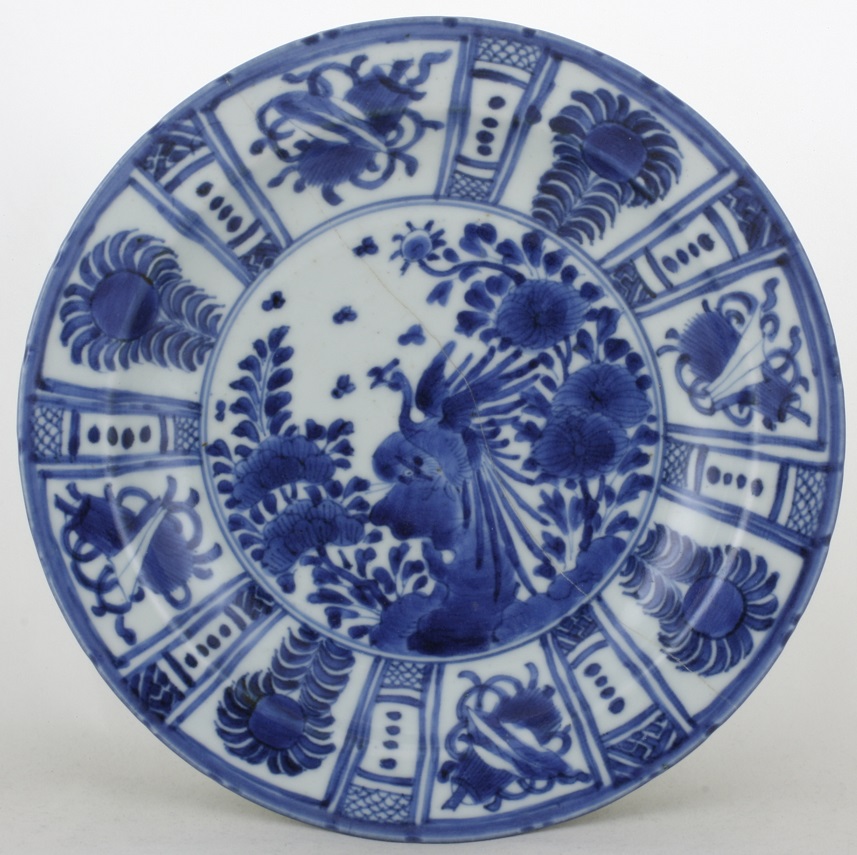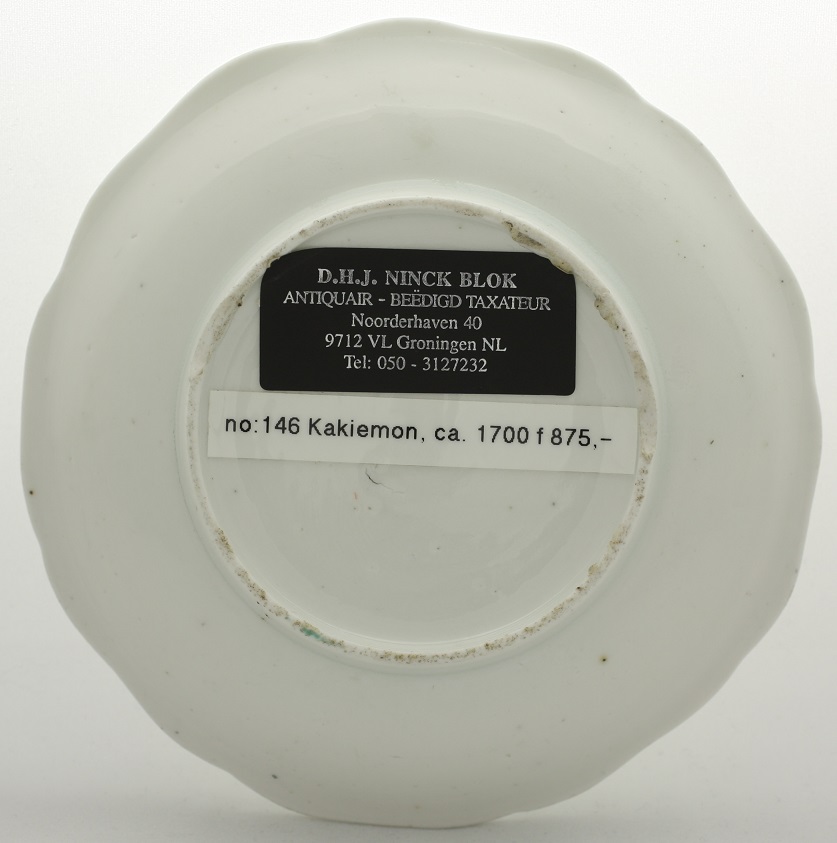Japanese Porcelain
Japanese Kakiemon / Kakiemon-style wares
Page 1
When internal wars began to impede the production of, and consequently the trade in, Chinese porcelain toward the end of the Ming Dynasty (1368-1644), several Dutch Merchants began to buy porcelain in Japan. At the same time, the production of faience pottery in Delft was stimulated, in order to compensate the shortage of Chinese porcelain. From 1658 onward, the Dutch East India Company, (Vereenigde Oost-Indische Compagnie, VOC) also recognized these commercial opportunities and began to order greater quantities of porcelain from Japan. In addition to a very diverse assortment of blue-and-white porcelain. largely in the style of traditional Chinese export goods, the coloured Japanese porcelain formed an unexpected new article in the Netherlands. It soon became very fashionable and the Company was able to generate a great deal of profit in this field.
One potter who benefited greatly from the new Dutch orders was Sakaida Kakiemon, who owned a porcelain kiln near Nangawara, just outside Arita. His porcelains characterized by a lucid whit composition and texture with decorations in various tints of enamel including orange-red, grass-green and blue.
Japanese Kakiemon / Kakiemon-style wares - Kakiemon
Currently there are no Japanese Kakiemon / Kakiemon-style - Kakiemon wares for sale.
Japanese Kakiemon / Kakiemon-style wares - Kakiemon-style wares

Japanese Kakiemon / Kakiemon-style wares - Kakiemon-style wares - Page 1
Object 2012507
Dish
Japan
1680-1700
Height 28 mm (1.10 inch), diameter of rim 222 mm (8.74 inch), diameter of footring 123 mm (4.84 inch), weight 384 grams (13.55 ounce (oz.))
Dish on footring, flat rim. On the base four spur-marks in a Y-pattern. Decorated in underglaze blue with two Hó-ó birds perched on a rock amongst chrysanthemums and peonies. On the sides and rim a border with birds, flowers and scrolling foliage. The reverse is undecorated.
Comparison between object 2012507 and sold object 2012506 (not included in this sale/offer.)
Barry Davies states that plates of this design appear to have one of two types of borders: birds in flight amongst flowers and foliage, or one of Kraak style. This design is also known in coloured enamels. Sherds of similar examples have been found at the Kakiemon kiln site. (London 1997, p.36)
In Japan the bird on the rock, the Hó-ó, is a mythological animal, emblematic of imperial authority. It is considered a symbol of wisdom, strength and also an inhabitant of the Buddhist Paradise. According to legend it would perch only on a kiri- or Paulownia Imperialis tree (Chinese: Wu t’ung). Carving the wood of the kiri is an art form in Japan and China. Several Asian string instruments are made from it, including the Japanese koto. The leaves and blossom of the Paulownia Imperialis became the official crest (mon) of the Empress of Japan. The kiri tree is emblematic of rectitude (Arts 1983, p.133 & 149)
According to Fitski Kakiemon production can be divided into two groups: pieces made in Nangawara which we call 'Kakiemon' and pieces made in Uchiyama, for which we use the appellation 'Kakiemon style'. This dish is representative of a group of pieces, mainly dishes, without the milky-white nigoshide body which is the main characteristic of Kakiemon. In this case, the porcelain is greyish with some impurities or kiln grit on the front and back. Such pieces were not made by the Kakiemon kiln, but by contemporary competitors and are therefore referred to as Kakiemon style. (Jörg 2003/1, p.75 & cat. 62), (Fitski 2011, pp.70-71, p. 90 & p. 97)
For similarly shaped, sized and in underglaze blue, Kakiemon-style decorated dishes, please see
- Ko-Imari from the collection of Oliver Impey, (Barry Davies Oriental Art, London, 1997), pp. 100-101, cat. 49.
- Sold Ceramics - Sold Kakiemon / Kakiemon style wares - Objects 2011910A, 2011930 and 2011931.
For a similarly, in underglaze blue with enamels, Kakiemon-style decorated dish, please see:
- Ko-Imari from the collection of Oliver Impey, (Barry Davies Oriental Art, London, 1997), pp. 100-101, cat. 49.
- Complete Catalogue of the Shibata Collection, (The Kyushu Ceramic Museum, Kyushu 2003), p.201, cat. 1545.
For a similarly shaped, sized and in underglaze blue, Kakiemon-style decorated dish with the Kraak-style border please see:
Condition: Some firing flaws.
References:
Fitski 2011, pp.70-71, p.90 & p.97, cat. 108, 109 & 110
Price: € 799 Currency Converter

Object 2010140
Saucer
Japan
c.1700
Provenance: Mr D.H.J. Ninck Blok, Groningen, the Netherlands.
Height 21 mm (0.83 inch), diameter of rim 110 mm (4.33 inch), diameter of footring 59 mm or (2.32 inch), weight 70 grams (2.47 ounce (oz.))
Saucer on footring, spreading sides with an everted and foliated rim. Kakiemon decorated in enamels with a bird perched on the branch of a blossoming prunus tree growing from rocks near water. The reverse is undecorated. On the base two labels, the first a rectangular black paper dealer label with silver letters that reads: ' D.J.H. Ninck Blok antiquair - beëdigd taxateur, Noorderhaven 40, 9712 VL Groningen NL Tel: 050-3127232. The second label is a rectangular plastic label with black letters that reads 'no: 146 Kakiemon, ca.1700 f 875,-.
This saucer was originally described as 'Kakiemon' by the well-respected Dutch antiques dealer Mr. D.J.H. Ninck Blok from Groningen (see the label on the base). Since I bought this saucer in 1996 I have come to the conclusion that it should actually have been classified as Kakiemon-style rather than Kakiemon. The quality of the pureness of the porcelain and the quality of the decoration both indicate that it was made in kilns competing with those of the original Kakiemon products.
In China, the blossoms of the Prunus mume (ume) symbolize purity and renewal, and occur very early on in Chinese painting, frequently in combination with pine and bamboo. In Japan, it primarily heralds the coming of spring, and is also used in art and literature to evoke the feel of the cold of winter loosening its grip. The delicate scent of the blossoms also evokes memories of a love one for many poets. The incisively painted, angular branches of the Prunus mume are a very characteristic element of Kakiemon, mostly depicted with fine black lines and clear red blossoms against the white porcelain. The blossoms are sometimes blown up to almost chrysanthemum-like proportions, and it is mostly depicted in a fairly stylized manner. Bamboo (take) is evergreen, and pliable, yet very strong. It is quick to recover after a heavy snowfall or a storm. In Japan, these qualities have led to its representation of indomitability, and the posture that a wise person should adopt, particularly in times of adversity. On kakiemon, bamboo has this connotation primarily in combination with Prunus mune and pine. The pine tree (matsu), an evergreen capable of living to extreme old age, represents power, a long and happy life, and even immortality. On Kakiemon porcelain we see it depicted as an old, venerable tree, but also sometimes as a young shoot, in combination with the crane. The brushwood fence (shibagaki) is made of bundles of twigs tied together, it is frequently combined with a bamboo trellis, an enlarged branch of flowering tree peony, and a shishi. It is a motif that occurs frequently on Kakiemon, with or without these companions, and one which evidently appealed greatly to the European consumer, given the fact that it is often seen on European imitations of Kakiemon. (Fitski 2011, p.148, p.151, pp.153-154 & p.163)
(2010140 reverse side)
For an identically shaped and sized and Kakiemon decorated saucer, please see:
Condition: A chip to the inner footring.
References:
Fitski 2011, p.148, p.151, pp.153-154 & p.163
Price: € 1.099 Currency Converter





 create websites
create websites